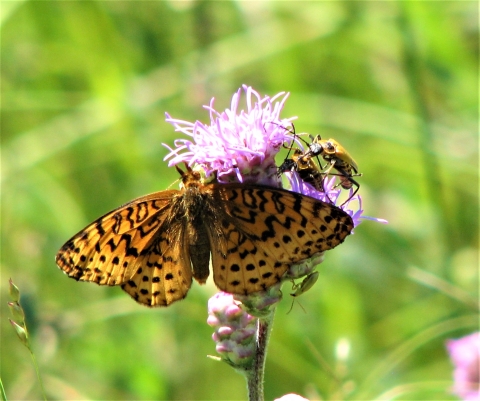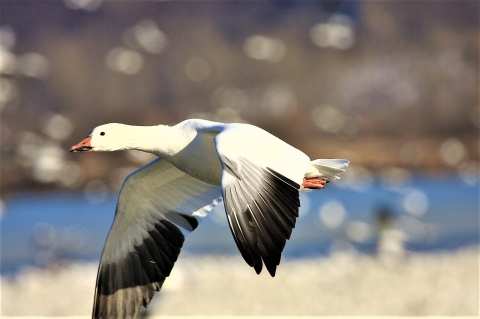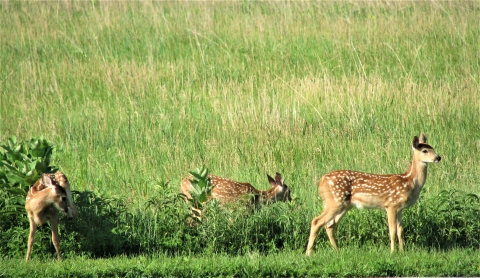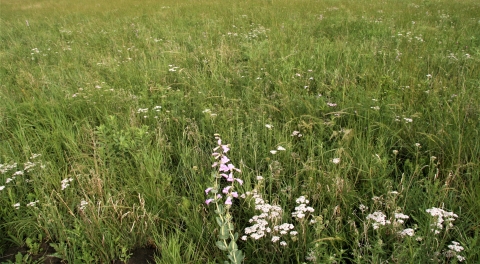Seasons of Wildlife
Butterflies & Pollinators
Combined ecological pressures of the loss of native prairie, certain agricultural practices, and the use of pesticides have accelerated the decline in members of the milkweed family, the only species that support monarchs in their larval stages. Nationwide, monarch numbers have dropped precipitously in the last several years to levels quickly becoming insufficient to sustain the population.
In an effort to call attention to the plight of the monarch butterfly, the Madison Wetland Management District office has a limited supply of free butterfly garden kits immediately available at the headquarters. Kits contain locally-adapted, native wildflower seed suitable for a 20’ space, a common milkweed plant ready for transplanting, and a butterfly house.
The plant species contained in the kit will provide necessary resources for a variety of pollinating insects on which humans depend for our own food resources. Readily available perennials such as blazing star, butterfly milkweed, lavender, and coral bells, and annuals such as zinnias, calibrachoa, nasturtium, and African daisy from your local greenhouse can be added for extra diversity. A surprising array of commercially available milkweeds would make a colorful monarch-specific garden!
Waterfowl
Giant Canada geese were reintroduced into eastern South Dakota from the late 1960s through the 1980s; they have now become common nesters in every part of the District. Blue-winged teal and mallards are the most common ducks on Madison Wetland Management District. Other frequently observed breeding ducks are northern pintails, gadwalls, ruddy ducks, and redheads. Other waterbirds common to the District include American white pelicans, double-crested cormorants, herons, gulls, terns, and shorebirds.
Mammals
Mammals, including white-tail deer, mink, muskrat, beaver, skunk, raccoon, red fox, coyote, and badger are in abundance. The largest North American land mammal in existence, American bison were a key species of the Great Plains—their grazing habits helped establish the distribution of grasslands in the Plains.
Native Prairie
The Great Plains of North America once covered over a million square miles through the center of the continent. These vast grasslands were shaped under disturbances such as fire, repeated grazing, and frequent droughts. The eastern third of this prairie ecosystem, from Manitoba, to Illinois and south to Texas, is known as the tallgrass prairie region. Tallgrass prairie once stretched across almost 200 million acres, but today, less than 1% of the original tallgrass prairie remains.
The rich soils that developed over hundreds or thousands of years combined with a gently rolling topography, made the region perfect for agriculture. When John Deere patented his plow made of steel in 1865, native prairie didn’t have a chance. Within 10 years, from 1860-1870, most of the tallgrass prairie was gone.
Featured Species
In the spring and fall, thousands of snow geese may be observed passing through the District, with the largest numbers often seen in a corridor from the town of Madison to 40 miles west of Madison.
Waterfowl need both grasslands and wetlands to live and raise their young. The wetlands supply abundant food, while thick upland vegetation offers ideal nesting sites and cover for newly hatched ducklings. Unfortunately, over time, settlement, agriculture, and development have reduced the prairie landscape from an ocean of grasses to a patchwork of lands in the midst of croplands, roads, and cities.
Shallow, temporary wetlands are important because they warm up first in the spring and produce protein-rich food for migrating and breeding waterfowl. Deep, permanent marshes hold water throughout the summer and provide a safe place for ducklings to grow.
Each waterfowl production area waterfowl production area
Waterfowl production areas are small natural wetlands and grasslands within the National Wildlife Refuge System that provide breeding, resting and nesting habitat for millions of waterfowl, shorebirds, grassland birds and other wildlife. Virtually all waterfowl production areas are in the Prairie Pothole Region states of Iowa, Minnesota, Montana, North Dakota and South Dakota.
Learn more about waterfowl production area is unique in size, wetland type, and plant and animal community. Waterfowl production areas provide for the needs of a wide range of animals such as nesting ducks, migrating geese, shorebirds, deer, muskrats, ring-necked pheasants, and Neotropical songbirds.







